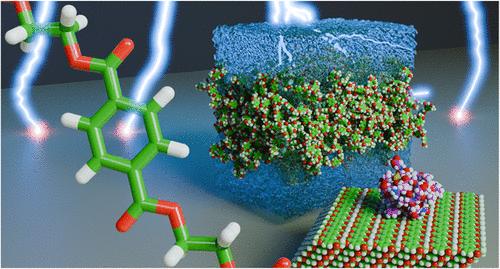当前位置:
X-MOL 学术
›
Macromolecules
›
论文详情
Our official English website, www.x-mol.net, welcomes your
feedback! (Note: you will need to create a separate account there.)
Structural and Electronic Properties of Poly(ethylene terephthalate) (PET) from Polarizable Molecular Dynamics Simulations
Macromolecules ( IF 5.1 ) Pub Date : 2024-11-07 , DOI: 10.1021/acs.macromol.4c02109 Marcelo D. Polêto, Justin A. Lemkul
Macromolecules ( IF 5.1 ) Pub Date : 2024-11-07 , DOI: 10.1021/acs.macromol.4c02109 Marcelo D. Polêto, Justin A. Lemkul

|
The environmental and economic challenges posed by the widespread use and disposal of plastics, particularly poly(ethylene terephthalate) (PET), require innovative solutions to mitigate their impact. Such mitigation begins with understanding physical properties of the polymer that could enable new recycling technologies. Although molecular simulations have provided valuable insights into PET interactions with various PET hydrolases, current nonpolarizable force fields neglect the electronic polarization effects inherent to PET interactions. Here, we present parameters for PET polymer and its derivatives that are compatible with the Drude polarizable force field. Our parameter fitting protocol accurately reproduces electrostatic properties from quantum mechanical calculations. We then studied electronic properties of PET amorphous slabs and PET crystal units, revealing a crucial electronic polarization response of PET residues at the interface with water or vacuum, yielding insights into the modulation of electrostatic properties by solvent molecules. Finally, we showcase the interaction between a carbohydrate-binding protein and the PET crystal unit, revealing the role of electronic polarization in enhancing binding affinity. This study represents the first extension of the Drude polarizable force field to a synthetic polymer, offering a robust tool for exploring PET material properties and advancing the design of efficient (bio)technologies for addressing plastic pollution.
中文翻译:

来自极化分子动力学模拟的聚对苯二甲酸乙二醇酯 (PET) 的结构和电子特性
塑料,尤其是聚对苯二甲酸乙二醇酯 (PET) 的广泛使用和处置所带来的环境和经济挑战,需要创新的解决方案来减轻其影响。这种缓解措施始于了解聚合物的物理特性,从而实现新的回收技术。尽管分子模拟为 PET 与各种 PET 水解酶的相互作用提供了有价值的见解,但目前的非极化力场忽略了 PET 相互作用固有的电子极化效应。在这里,我们提出了与 Drude 极化力场兼容的 PET 聚合物及其衍生物的参数。我们的参数拟合协议准确地再现了量子力学计算中的静电特性。然后,我们研究了 PET 非晶板和 PET 晶体单元的电子特性,揭示了 PET 残留物在与水或真空界面处的关键电子极化响应,从而深入了解溶剂分子对静电特性的调制。最后,我们展示了碳水化合物结合蛋白与 PET 晶体单元之间的相互作用,揭示了电子极化在增强结合亲和力中的作用。这项研究代表了 Drude 极化力场首次扩展到合成聚合物,为探索 PET 材料特性和推进解决塑料污染的高效(生物)技术设计提供了强大的工具。
更新日期:2024-11-09
中文翻译:

来自极化分子动力学模拟的聚对苯二甲酸乙二醇酯 (PET) 的结构和电子特性
塑料,尤其是聚对苯二甲酸乙二醇酯 (PET) 的广泛使用和处置所带来的环境和经济挑战,需要创新的解决方案来减轻其影响。这种缓解措施始于了解聚合物的物理特性,从而实现新的回收技术。尽管分子模拟为 PET 与各种 PET 水解酶的相互作用提供了有价值的见解,但目前的非极化力场忽略了 PET 相互作用固有的电子极化效应。在这里,我们提出了与 Drude 极化力场兼容的 PET 聚合物及其衍生物的参数。我们的参数拟合协议准确地再现了量子力学计算中的静电特性。然后,我们研究了 PET 非晶板和 PET 晶体单元的电子特性,揭示了 PET 残留物在与水或真空界面处的关键电子极化响应,从而深入了解溶剂分子对静电特性的调制。最后,我们展示了碳水化合物结合蛋白与 PET 晶体单元之间的相互作用,揭示了电子极化在增强结合亲和力中的作用。这项研究代表了 Drude 极化力场首次扩展到合成聚合物,为探索 PET 材料特性和推进解决塑料污染的高效(生物)技术设计提供了强大的工具。


















































 京公网安备 11010802027423号
京公网安备 11010802027423号